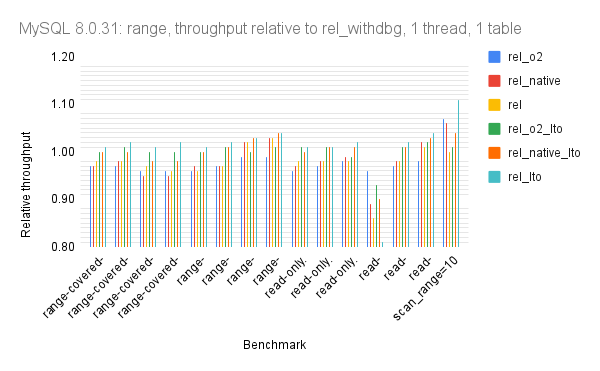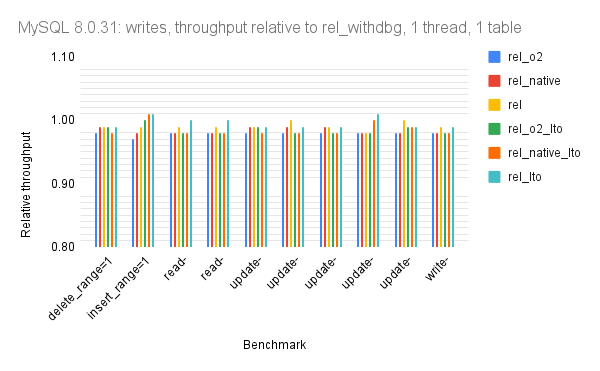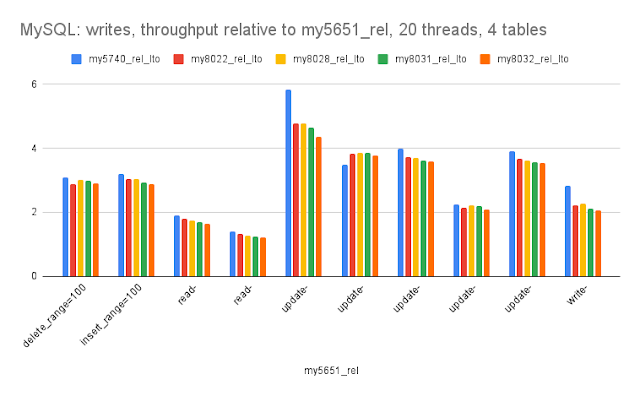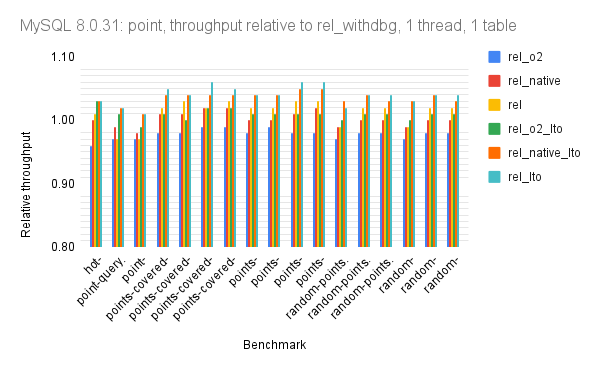I measured the time it takes to build Postgres, upstream MySQL and FB MySQL from source on my home servers (Beelink, see here) using Postgres 15.2, upstream MySQL 8.0.32 and FB MySQL 8.0.28.
tl;dr
- Build times in seconds: 619 for Postgres, 5294 for upstream MySQL, 8443 for FB MySQL
- Postgres is by far the fastest to compile. Reasons for that include that it uses C and has fewer things to compile
- FB MySQL spends ~2700 seconds compiling RocksDB related things. Without that overhead the FB MySQL build would be 5601 seconds vs 5294 for upstream MySQL. For reasons I don't understand yet, most of the RocksDB source files are compiled 3 times (for the storage engine, ldb binary and sst_dump binary). If that could be avoided then the build time would be reduced by ~20%.
Setup
While the server has 8 cores I did a non-parallel make (make -j1).
The build configuration (configure & CMake command lines) for each DBMS is here.
Methods
For Postgres I just measure the total time to build. For upstream and FB MySQL I also measure the time for each build target. That is done in two steps.
- Run make and add timestamps to the output. Smart people on Twitter explained how to do that.
- Parse the output from make to get per-target compile times
make 2>&1 | ts '[%s]' | tee o.time
grep "Built target" o.time | tr '[]' ' ' | \awk '{ $2=""; $3=""; $4=""; print $0 }' | \awk '{ if (NR==1) { printf "%s\t%s\n", $1 - itime, $2 } else { printf "%s\t%s\n", $1 - lastTS, $2 }; lastTS=$1 } ' itime=$firstTS | \sort -rnk 1,1 | head -10
Legend
619 NA Postgres
5294 255 upstream MySQL
8443 251 FB MySQL
Results: detailed
The time in seconds for the top-20 build targets
For upstream MySQL 8.0.32:
636 innobase
433 sql_gis
393 sql_dd
301 group_replication
294 perfschema
209 icui18n
190 mysqld
153 libprotoc
128 icuuc
123 libprotobuf
99 slave
96 binlog
65 mysql_server_component_services
65 mysqlgcs
54 mysys_objlib
49 myisam_library
44 mysqlpump_lib
33 libprotobuf-lite
30 mysqlbinlog
For FB MySQL:
The RocksDB related build targets are rocksdb_se, ldb and sst_dump. From the output it looks like each of those repeats the same work -- as all or most of the RocksDB source files are recompiled for each. That explains why each target takes ~900 seconds. If the recompile could be avoided then the build time would be reduced by ~20%.
993 rocksdb_se
932 ldb
917 sst_dump
598 innobase
462 sql_dd
411 sql_gis
334 group_replication
332 perfschema
227 mysqld
212 icui18n
153 libprotoc
131 slave
129 icuuc
123 libprotobuf
97 binlog
65 mysqlgcs
57 mysys_objlib
54 mysql_server_component_services
47 myisam_library












